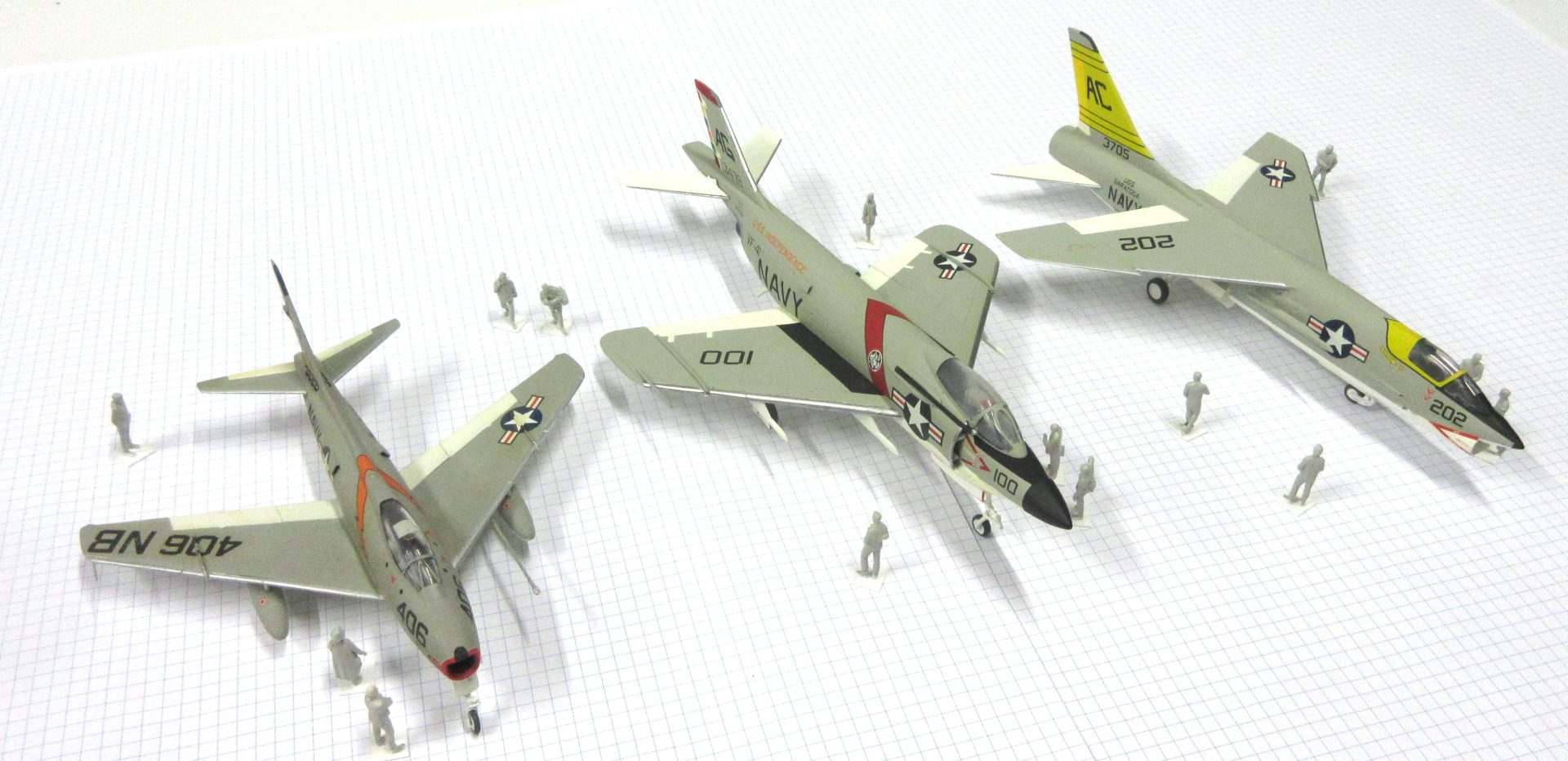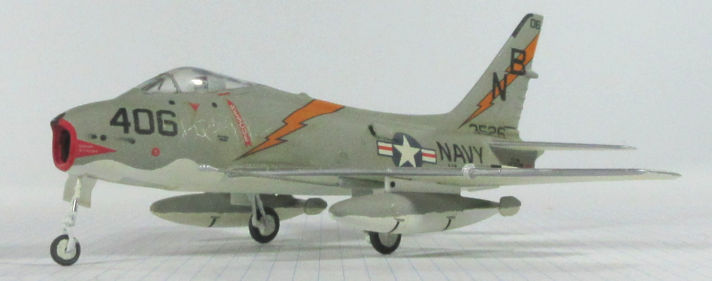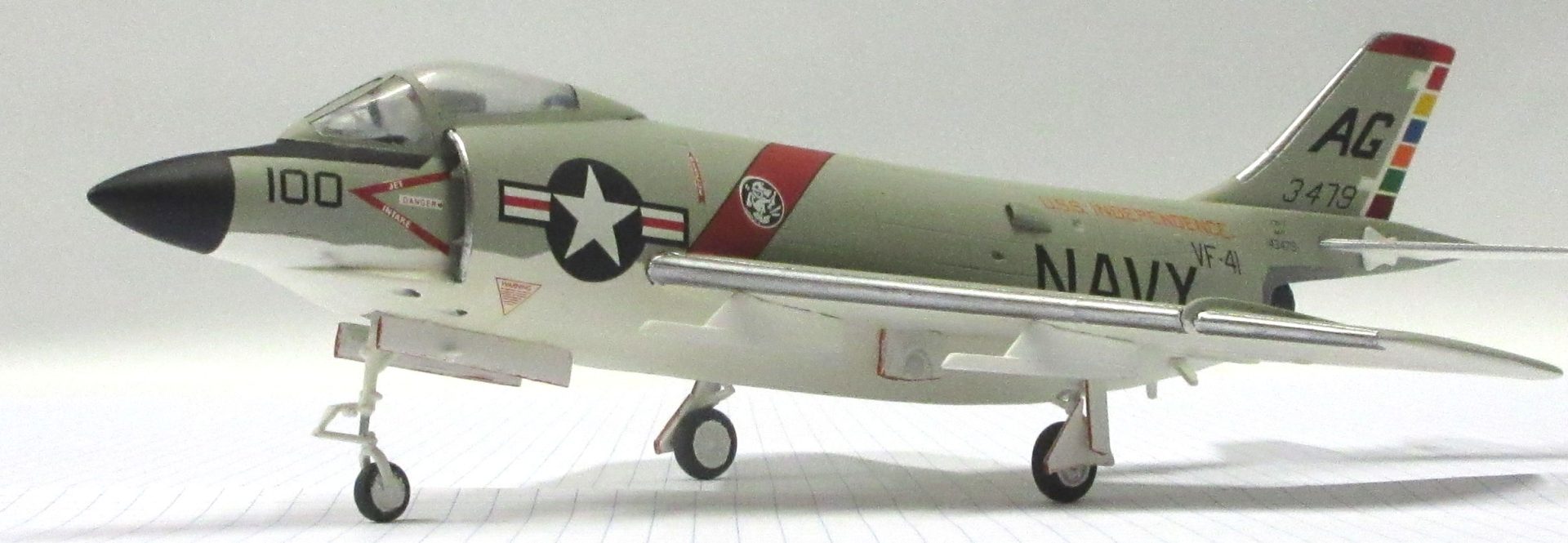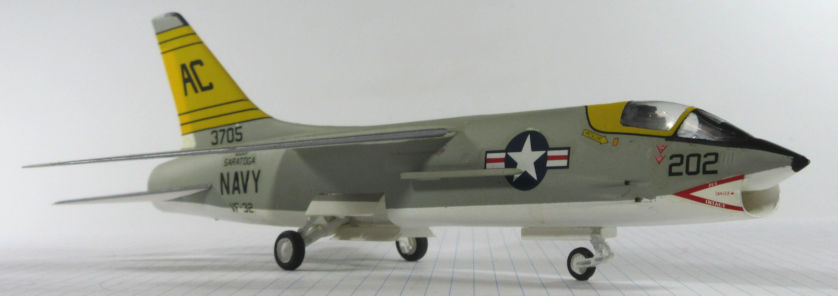Light Gull Grey and White
North American FJ-4B – McDonnell F3H-2N – Vought F8U-1

Later in the Pacific War the United States Navy adopted a simplified paint scheme for its aircraft of Gloss Sea Blue (also referred to as Dark Blue of Dark Sea Blue). It was appropriate at the time when the Navy was fighting the Japanese over the Pacific Ocean but when its aircraft found themselves engaged in warfare over Korea that scheme made them too conspicuous and research began into a new scheme to suit the force’s new circumstances. The result was a new scheme of an upper surface painted Light Gull Grey as the least conspicuous colour at altitude and Gloss White to provide a reflective coating against the heat and flash of atomic weapons. These colours started appearing on US Navy aircraft from February 1955 and all carrier based aircraft were to be painted in that scheme by July 1957. Let’s look at three early US Navy aircraft in this new scheme.
North American FJ-4B in 1/72 by Emhar
This aircraft was the ultimate version of the FJ-1 Fury which was one of the first jet aircraft flown by the US Navy. This FJ-4 version had much in common with the US Air Force’s F-86 Sabre with its swep wing and other advanced features. It was an interceptor and fighter-bomber and the FJ-4B was also capable of carrying nuclear weapons. The FJ-4 first flew in October 1954, they began entering service in February 1955 and 222 were produced. They eventually flew with ten US Navy and three Marine Corps squadrons between 1955 and 1964.
This model was made using the Emhar kit that was first published in 1989 and re-released by Revell in 1996. The only other kits of the FJ are the Sword 1/72 FJ-2 and RVHP FJ-3 kits which are almost certainly better kits than this Emhar one. However, apart from this Emhar kit the only other options are the ancient Rareplanes vacform kit and the Merlin Models primitive limited run kits (both of which I’ve owned and disposed of). The Emhar kit is not difficult to build but it is primitive by current day standards. As the review in Modelling Madness says, you get a decent representation out of the box ‘but there’s lots of room for improvement’.
McDonnell F3H-2 in 1/72 by Emhar
Development of this aircraft began in the late 1940s to give the US Navy a short range interceptor but American encounters with MiG-15s during the Korean War led to a re-design into an all-weather fighter. However, this change led to a much heavier aircraft and the poor performance of the jet engine selected for it led to a fighter with much lower performance than expected. Even so, it entered service with the Navy as an all weather, missile armed aircraft that supplemented its day fighters. Over 500 were manufactured and they remained in service between 1956 and 1964. The inadequacy of this aircraft led McDonnell to design and build their famous F-4 Phantom II fighter.
This model was also made using an Emhar kit which was published in a couple of F3H-2 versions between 1991 and 2011. Like the above Emhar FJ-4 kit, this is not difficult to make but has some accuracy problems and needs a bit of work to achieve a reasonable model, You will find a comprehensive build review on Modelling Madness. A better option is the Sword limited run injection moulded kit that was first published in 2019. It has received decent reviews on Hyperscale and on the Fine Scale Modeler website . I’ve bought one, it looks good in the box and I will get around to making it one of these days.
Vought F8U-1 in 1/72 converted from Heller
This aircraft was designed for the US Navy in the early 1950s as a high performance interceptor and became a highly regarded fighter. A unique feature of its design was the variable incidence wing which could be raised to improve visibility during take-off and landing on aircraft carriers. The F8U-1, which was renamed the F-8A in 1962, was the first of several versions and eventually over 1,200 were manufactured. They served with the US Navy from 1957 to 1987 and played an important part in the air war over Vietnam. They also served with the Philippines Air Force until 1991 and France’s Aeronavale until 1999.
This model was made by lightly converting the Heller kit. There are a few kits of the F-8 Crusader around that include the Heller kit first published in 1978, the Hasegawa kit first published in 1987, Esci/Ertl/Italeri kit published in 1988, the Revell kit also first published in 1988 and the Academy kit first published in 2004. The general consensus in the ARC Forum is that the Academy kit is the best and the reviews in Cybermodeler Online and Modelling Madness agree. However I prefer the old Heller kit which was made during that manufacturer’s golden age when it was so far ahead of the pack that it was lonely. I still rates as a good kit today and is easily and cheaply found at swap meets. Conversion from the F-8E kit to the F8U-1 (F-8A) is not difficult and mainlt involves the nose and tail. Finding decals for it might be the hard part of the project.



